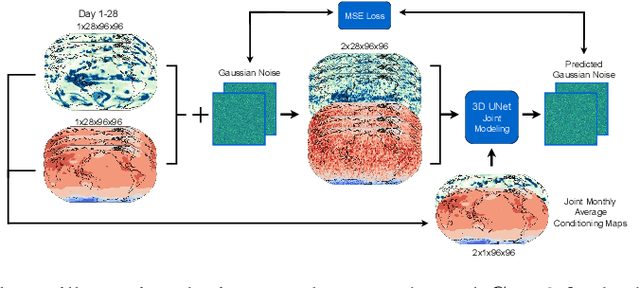Katie Christensen
Diffusion-Based Joint Temperature and Precipitation Emulation of Earth System Models
Apr 12, 2024



Abstract:Earth system models (ESMs) are the principal tools used in climate science to generate future climate projections under various atmospheric emissions scenarios on a global or regional scale. Generative deep learning approaches are suitable for emulating these tools due to their computational efficiency and ability, once trained, to generate realizations in a fraction of the time required by ESMs. We extend previous work that used a generative probabilistic diffusion model to emulate ESMs by targeting the joint emulation of multiple variables, temperature and precipitation, by a single diffusion model. Joint generation of multiple variables is critical to generate realistic samples of phenomena resulting from the interplay of multiple variables. The diffusion model emulator takes in the monthly mean-maps of temperature and precipitation and produces the daily values of each of these variables that exhibit statistical properties similar to those generated by ESMs. Our results show the outputs from our extended model closely resemble those from ESMs on various climate metrics including dry spells and hot streaks, and that the joint distribution of temperature and precipitation in our sample closely matches those of ESMs.
RoseNet: Predicting Energy Metrics of Double InDel Mutants Using Deep Learning
Oct 20, 2023Abstract:An amino acid insertion or deletion, or InDel, can have profound and varying functional impacts on a protein's structure. InDel mutations in the transmembrane conductor regulator protein for example give rise to cystic fibrosis. Unfortunately performing InDel mutations on physical proteins and studying their effects is a time prohibitive process. Consequently, modeling InDels computationally can supplement and inform wet lab experiments. In this work, we make use of our data sets of exhaustive double InDel mutations for three proteins which we computationally generated using a robotics inspired inverse kinematics approach available in Rosetta. We develop and train a neural network, RoseNet, on several structural and energetic metrics output by Rosetta during the mutant generation process. We explore and present how RoseNet is able to emulate the exhaustive data set using deep learning methods, and show to what extent it can predict Rosetta metrics for unseen mutant sequences with two InDels. RoseNet achieves a Pearson correlation coefficient median accuracy of 0.775 over all Rosetta scores for the largest protein. Furthermore, a sensitivity analysis is performed to determine the necessary quantity of data required to accurately emulate the structural scores for computationally generated mutants. We show that the model can be trained on minimal data (<50%) and still retain a high level of accuracy.
* Presented at Computational Structural Bioinformatics Workshop 2023
 Add to Chrome
Add to Chrome Add to Firefox
Add to Firefox Add to Edge
Add to Edge